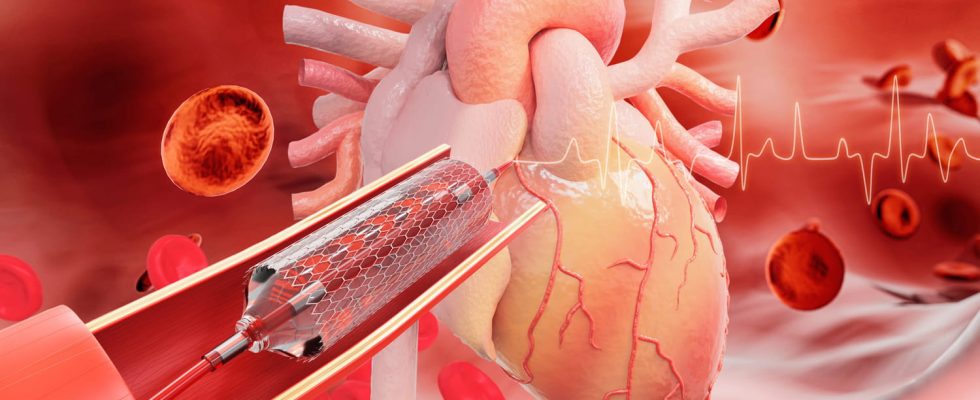Coronary angiography is a painless examination that visualizes the arteries of the heart. Placement of a stent may be necessary depending on the results. Principle, duration, anesthesia, rest after…
Coronary angiography is an examination that allows the cardiologist to see coronary arteries when he suspects a coronary disease, such as a narrowing of the arteries of the heart for example. This is a invasive examination since it is necessary to puncture the femoral or radial artery to allow the introduction of a catheter (flexible tube) into the arteries. In which cases should it be practiced? How is the exam going ? What are the risks or side effects?
What is the definition of coronary angiography?
There coronary angiography East an examination to visualize the arteries of the heart (coronary arteries). This is an imaging test using the technique of X-ray radiography and injection of an iodinated contrast product. “It’s a invasive examination, immediately warns Dr. Florian Zores, cardiologist. It requires the puncture of an artery (most often the radial artery at the wristmore rarely the femoral artery at the level of the fold of the groin) and the circulation of probes to the cardiac arteries.”
What are the indications for coronary angiography?
Coronary angiography can precisely visualize the anatomy of the three coronary arteries supplying the heartand to highlight any narrowings (stenoses) or blockages of the arteries by atheroma and/or blood clots and to assess their severity.
► In first intention: Coronary angiography is examination performed during myocardial infarctionin order to identify the artery responsible for the “heart attack”.
► In second intention: in case angina pectoris (angina) after performing an exercise test, stress echocardiography or myocardial scintigraphy.
► Systematically: before heart surgery (operation of the heart valves in particular) in order to treat, possibly, during the same operating procedure, the diseased arteries.
► “Other indications may be asked by the cardiologist, depending on the particular case of each patient“explains Dr. Zores
The exam takes place in a specially equipped radiology room. Due to the introduction into the body of material, the procedure is carried out in sterile conditions, like in the operating room. The interventional cardiologist is dressed like a surgeon: sterile gown and gloves, mask and cap. A systematic preliminary examination will have made it possible to detect possible (but rare) contraindications such as an allergy to the contrast product (iodine).
► The patient, after having local anesthesiais elongated, with an empty stomach (no drink or food 4 hours before), on an examination table, and a camera rotates around him to acquire images of the coronary arteries from many angles.
► The interventional cardiologist will prick (puncture) into the chosen artery as an approach (radial or femoral) and place a catheter which will make it possible to pass very fine hollow probes. The probes are pushed through the circulation to ascend to the origin of the heart arteries. Once properly positioned, they allow injection of iodinated contrast productopaque to X-rays, which makes it possible to view all of the coronary arteries via the camera. “The examination is painless. The injection of the contrast product may be accompanied by a sensation of heat“, specifies our interlocutor.
► At the end of the exam, the probes and catheter are removed and the radial artery (or femoral) is manually compressed to prevent bleeding; then a pressure dressing is applied and the patient can return to his room.
How long does a coronary angiogram take?
A simple coronary angiogram generally lasts between 20 and 30 minutes.
Should a stent be placed after coronary angiography?
The results can be divided into two cases.
► In the first case, there is no abnormality ; there is therefore no need to propose any specific treatment.
► In the second case, lesions are evident. Depending on the characteristics of the coronary disease, revascularization can be done in two ways:
- Dilation of the diseased artery(ies) (angioplasty) and stentingperformed by the interventional cardiologist,
- Aorto-coronary bypass performed by the surgeon
Revascularization is not mandatory and some shrinkage does not justify placement of a stent or surgery. In all cases (angioplasty, surgery or neither), drug treatment is systematically prescribed to fight coronary disease. The choice of treatment depends on various factors and on a discussion between the patient, the cardiologist and the surgeon (medico-surgical discussion)
What are the risks of coronary angiography? Risk of death?
“There is no particular fatigue expected after coronary angiography, but the disease that motivated the realization of the examination can cause fatigue (infarction in particular)“explains Dr. Zores. Some nausea may nevertheless occur following the injection of iodinated contrast product. Like any invasive examination, coronary angiography presents a risk of complications. “The risk of serious complications is rare, reassures Dr. Zores. The risk of death is estimated to be less than 1 in 1000“.
What type of anesthesia for coronary angiography?
The exam is done after local anesthesia of the area where the arterial puncture will then be performed. There is no general anesthesia.
How long to rest afterwards?
The resumption of a professional activity depends on the context in which the coronary angiography was carried out, and on the result of the examination. The cardiologist will specify the duration of any work stoppage.
What advice after coronary angiography?
Radial coronary angiography allows the patient to stand up almost immediately upon completion of the examination. That performed via the femoral route requires lie down for a few hours to avoid possible hematoma. Most often the patient can go home the same evening or the day after the exam. In the event of an anomaly at the puncture point (place where the probes were introduced), medical advice is desirable.
Thanks to Doctor Florian Zores, cardiologist.
